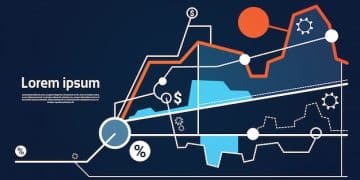Future of Remote Work: Legal & Economic Shifts for US Companies

The future of remote work for US companies hinges on critical legal and economic adaptations, requiring businesses to proactively navigate evolving regulatory landscapes, manage distributed talent effectively, and embrace new fiscal strategies to remain competitive and compliant in a perpetually shifting global marketplace.
The landscape of work has undergone a seismic shift, with remote paradigms evolving from a niche perk to a mainstream operational model. For US companies, understanding the future of remote work: navigating legal and economic implications for US companies is no longer optional but a strategic imperative. This transformation brings with it a complex web of challenges and opportunities that demand meticulous attention from executives, HR professionals, and legal teams alike.
The Evolving Legal Landscape of Remote Work
As remote work firmly entrenches itself within the corporate structure, the legal frameworks governing it are struggling to keep pace. US companies face a myriad of evolving regulations, from labor laws to data privacy, all of which demand careful consideration to avoid costly non-compliance. What was once a relatively straightforward employee-employer relationship becomes a multi-jurisdictional puzzle when employees are dispersed across states or even countries.
One of the primary legal hurdles involves state and local tax implications. When an employee resides in a state different from the company’s headquarters, it can trigger nexus, obligating the company to register and pay taxes in that new state. This complexity is compounded by varying state income tax laws, unemployment insurance requirements, and workers’ compensation regulations. Companies must be diligent in tracking employee locations and understanding their obligations in each jurisdiction where remote workers reside.
Navigating State-Specific Labor Laws and Regulations
Beyond tax implications, state-specific labor laws present a significant challenge. Each state has its own nuances regarding minimum wage, overtime, paid sick leave, family leave, and even break requirements. Applying uniform company policies across a remote workforce becomes difficult, necessitating a nuanced approach to compliance. For instance, a company based in Texas employing a remote worker in California must adhere to California’s more stringent labor laws for that employee.
- Wage and Hour Compliance: Ensuring proper classification and compensation according to local and state laws.
- Paid Leave Policies: Adhering to varying state mandates for sick days, family leave, and bereavement.
- Worker’s Compensation: Understanding the requirements and coverage obligations for employees across different states.
- Non-Compete and Confidentiality Agreements: Enforceability can vary significantly based on state jurisdiction.
Another area of increasing scrutiny is employee tracking and privacy. While companies may wish to monitor productivity or enforce data security, they must do so in a manner compliant with state and federal privacy laws. Overly intrusive monitoring tools can lead to legal challenges, particularly in states with strong employee privacy protections. Developing clear, transparent policies and obtaining employee consent are crucial steps.
Ultimately, the legal aspect of remote work requires a proactive and adaptive strategy. Companies should consider legal counsel specializing in multi-state employment law, utilize sophisticated HR information systems to track employee locations and applicable laws, and regularly review their policies to ensure they remain compliant with the ever-changing regulatory environment. Ignoring these legal complexities poses significant financial and reputational risks.
This evolving legal landscape mandates a continuous learning approach, ensuring that businesses stay ahead of potential liabilities by anticipating and adapting to new legislative developments. The emphasis must shift from a reactive to a proactive legal posture, mitigating risks before they materialize.
Economic Shifts and the Allure of Remote Work
Economically, remote work offers substantial opportunities for US companies, alongside unique challenges. The most apparent benefit is the potential for significant cost savings. Businesses can reduce or eliminate expensive office leases, cut down on utility bills, and decrease spending on office supplies and maintenance. This reduction in overhead can free up capital for investment in other areas, such as technology, research and development, or talent acquisition.
Beyond cost savings, remote work broadens the talent pool exponentially. Companies are no longer geographically constrained to hiring within a certain radius of their physical office. This access to a wider, more diverse talent pool allows businesses to find the best candidates for a role, regardless of their location, fostering increased innovation and competitiveness. It can also lead to more diverse teams, bringing varied perspectives and experiences to the organization.
Driving Efficiencies and Productivity in a Distributed Model
The economic considerations also extend to productivity. While initial concerns about remote work’s impact on output were widespread, many studies now suggest that employees can be equally, if not more, productive when working remotely. Flexible schedules, reduced commute times, and a more comfortable work environment can contribute to higher employee satisfaction and, consequently, increased efficiency. This positive impact on productivity translates directly into economic gains for the company.
- Reduced Overhead: Significant savings on real estate, utilities, and office maintenance.
- Broader Talent Pool: Access to a global workforce, leading to better hiring outcomes.
- Improved Productivity: Enhanced focus and flexibility often lead to greater output.
- Lower Employee Turnover: Increased satisfaction can reduce recruitment and training costs.
However, there are also economic challenges. Companies may need to invest more in technology infrastructure, cybersecurity measures, and remote collaboration tools. While these are initial investments, they are critical for enabling seamless remote operations. Furthermore, managing payroll and tax obligations across multiple jurisdictions can be administratively complex and potentially costly if not streamlined effectively.

Another economic consideration is the potential impact on local economies. As companies reduce physical office spaces, the ecosystem of businesses that support traditional offices—from cafeterias to transport services—may suffer. This broader economic shift is something economists and policymakers are closely monitoring. For individual companies, however, the economic benefits of remote work often outweigh these external considerations, driving a continued push towards flexible arrangements.
Ultimately, the economic narrative surrounding remote work is largely positive for adaptable businesses. Those that strategically embrace the model, invest wisely in foundational support systems, and optimize for dispersed operations stand to gain a significant competitive advantage in the modern economy.
Cybersecurity and Data Privacy in a Remote Environment
The shift to remote work has dramatically expanded the attack surface for cyber threats, making robust cybersecurity and data privacy measures paramount for US companies. Home networks often lack the same level of security as corporate offices, and employees may inadvertently expose sensitive data through unsecured Wi-Fi connections, personal devices, or phishing scams. This vulnerability poses significant financial and reputational risks for businesses.
Companies must implement comprehensive cybersecurity protocols specifically designed for a distributed workforce. This includes providing employees with secure company-issued devices, mandating the use of Virtual Private Networks (VPNs), and implementing multi-factor authentication (MFA) for all critical systems. Regular security audits and penetration testing are also crucial to identify and address vulnerabilities before they can be exploited.
Ensuring Data Protection and Regulatory Compliance
Data privacy is another critical concern, particularly with the proliferation of strict regulations like the California Consumer Privacy Act (CCPA) and the potential for a federal data privacy law. Companies must ensure that all data—whether customer, employee, or proprietary information—is handled, stored, and transmitted securely, regardless of the employee’s location. This involves encrypting data, implementing strict access controls, and training employees on best practices for data protection.
- VPN Implementation: Ensuring secure connections for all remote access to company networks.
- Multi-Factor Authentication (MFA): Adding layers of security to protect accounts and sensitive data.
- Employee Training: Equipping employees with the knowledge to recognize and avoid cyber threats.
- Data Encryption: Protecting sensitive information at rest and in transit.
The rise of shadow IT—the use of unauthorized software or hardware by employees—is also a concern in remote environments. Employees might use personal cloud storage solutions or consumer-grade communication apps for work-related tasks, bypassing corporate security measures. Companies need to educate employees about the risks of shadow IT and provide approved, secure alternatives that meet both productivity and security needs.
Moreover, responding to a data breach in a remote setting can be more challenging. Identifying the source of the breach, containing the damage, and complying with notification requirements across different jurisdictions demands a well-rehearsed incident response plan. Such plans must account for the dispersed nature of the workforce and the potential for data residing on various personal devices.
Investing in advanced cybersecurity tools, engaging security experts, and embedding a culture of security awareness throughout the organization are non-negotiable for companies embracing remote work. Failure to do so could result in crippling fines, loss of customer trust, and severe damage to the company’s long-term viability. The future of work requires a future-proof approach to digital security.
A robust cybersecurity strategy is not just about protection; it’s about maintaining trust and operational integrity in an increasingly digital and distributed world. Companies must view security as an ongoing process, continually adapting to new threats and technological advancements.
Talent Acquisition and Retention in a Remote-First World
The shift to remote work has fundamentally altered how US companies approach talent acquisition and retention. The traditional geographical boundaries for sourcing talent have dissolved, offering an unprecedented opportunity to recruit from a global talent pool. This broadens the diversity of candidates, potentially leading to more innovative and resilient teams.
However, this expanded talent pool also means increased competition. Companies are now competing not just with local businesses but with organizations worldwide for top talent. To attract and retain the best individuals, businesses must offer compelling remote work policies, competitive compensation packages, and a strong company culture that transcends physical location.
Building a Thriving Remote Culture and Employee Engagement
Retaining remote talent requires a deliberate focus on employee engagement and well-being. Isolation, burnout, and a lack of connection can be significant challenges for remote workers. Companies must invest in tools and strategies that foster a sense of belonging, facilitate effective communication, and support professional development. Regular check-ins, virtual team-building activities, and clear communication channels are essential.
- Flexible Work Policies: Offering autonomy and work-life balance to attract and retain talent.
- Virtual Team Building: Implementing online activities to foster connection and camaraderie.
- Professional Development: Providing accessible learning and growth opportunities for remote staff.
- Transparent Communication: Ensuring consistent and clear messaging across all levels of the organization.
Compensation strategies also become more complex in a remote-first world. Should companies pay based on the employee’s cost of living, or based on the company’s headquarters? There’s no single answer, and companies are experimenting with various models. Whatever the approach, transparency and fairness are key to avoiding resentment and ensuring equitable treatment among distributed teams.

Furthermore, onboarding remote employees requires a tailored approach. Without the benefit of in-person introductions and office tours, companies need structured virtual onboarding programs that ensure new hires feel welcomed, understand their roles, and are equipped with the necessary tools and information to succeed. Mentorship programs and buddy systems can be particularly effective in this context.
Ultimately, successful talent acquisition and retention in a remote environment hinge on creating an inclusive, supportive, and engaging culture that values flexibility, trust, and autonomy. Companies that master this balance will thrive in the future of work, securing the workforce needed to innovate and grow.
The future-ready company will be one that sees remote work as an opportunity to rethink talent strategies, not merely a logistical challenge. It’s about designing organizations that are inherently adaptable and empowering to individuals, regardless of their location.
Infrastructure and Technology Requirements for Scalable Remote Work
Scaling remote work effectively within US companies demands a robust and adaptable technological infrastructure. The ad-hoc solutions adopted during the initial pandemic surge are no longer sufficient; businesses need long-term investments in tools and systems that ensure seamless operation, communication, and security for a dispersed workforce. This includes reliable internet access, powerful collaboration platforms, and comprehensive cloud-based solutions.
High-speed, reliable internet connectivity is the foundational requirement. While companies can’t control employees’ home internet, they can provide stipends or ensure that employees have access to the necessary bandwidth. Beyond connectivity, secure and scalable cloud infrastructure is paramount for hosting applications, storing data, and enabling access from anywhere.
Leveraging Cloud Platforms and Collaboration Tools
Collaboration tools have become the virtual backbone of remote teams. Platforms that integrate video conferencing, instant messaging, project management, and document sharing are essential for maintaining productivity and fostering connection. Companies must select tools that are intuitive, secure, and compatible with their existing systems, ensuring a smooth workflow for all employees.
- Cloud Computing: Hosting applications and data securely for anytime, anywhere access.
- Unified Communication Platforms: Integrating chat, video, and file sharing for seamless team interaction.
- Hardware Provisioning: Ensuring employees have reliable and secure company-issued devices.
- IT Support and Helpdesk: Providing accessible and responsive technical assistance for remote issues.
The provisioning and management of hardware for remote employees also present a logistical challenge. Companies need effective processes for distributing, tracking, and maintaining laptops, monitors, software licenses, and other necessary equipment. Remote IT support capabilities are also critical, as technicians may not be able to physically access employee devices. Solutions like remote desktop management tools become invaluable.
Investing in virtual desktop infrastructure (VDI) or desktop-as-a-service (DaaS) solutions can provide an added layer of security and standardization, allowing employees to access a consistent, controlled work environment from any device. This also simplifies software updates and security patches, ensuring all employees are operating on secure and current systems.
As remote work evolves, so too will the technological landscape. Companies must remain agile, continually evaluating new tools and innovations that can enhance efficiency, security, and employee experience. A forward-thinking approach to technology is not just about enabling remote work; it’s about building a resilient and future-proof enterprise capable of adapting to any operational model.
Strategic investment in robust and scalable infrastructure is what elevates remote work from a temporary fix to a sustainable, competitive advantage. Companies that prioritize this will find themselves better positioned to weather future disruptions and thrive in a globally connected economy.
The Future of Office Space: Hybrid Models and Decentralization
The future of remote work is unlikely to be fully remote for most US companies; instead, a more probable outcome is the widespread adoption of hybrid models. This involves combining remote work with scheduled in-office days, offering employees the best of both worlds: the flexibility and autonomy of working from home, coupled with the benefits of in-person collaboration, team building, and mentorship. The office, therefore, transforms from a daily necessity into a purposeful destination.
This shift necessitates a re-evaluation of office space. Rather than large, traditional layouts, companies are increasingly looking at smaller, more flexible spaces designed for collaboration, meetings, and social interaction. Hot-desking, shared workspaces, and dedicated ‘collaboration hubs’ are becoming more common, replacing individual assigned desks with flexible arrangements that maximize efficiency when employees do come into the office.
Rethinking Real Estate and Operational Strategies
The economic implications for real estate are significant, with many companies shedding excessive office space to reduce costs. This can lead to substantial savings, but it also requires careful planning to ensure there’s enough space for teams when they need to convene. Some companies might opt for decentralized office hubs, smaller satellite offices spread across different regions, allowing employees to access a local workspace perhaps closer to home without a long commute to a central HQ.
- Hybrid Work Models: Blending remote and in-office work for optimal flexibility and collaboration.
- Flexible Office Layouts: Designing spaces for collaboration, meetings, and communal activities rather than individual desks.
- Reduced Real Estate Footprint: Downsizing traditional offices to cut costs and align with new work patterns.
- Decentralized Hubs: Establishing smaller regional offices to support local remote teams.
Operational strategies must also evolve. Managing a hybrid workforce requires clear policies on when and why employees should come into the office, effective scheduling tools to manage shared spaces, and equitable treatment for both in-office and remote employees. Ensuring that remote employees feel just as included and have equal access to opportunities as their in-office counterparts is crucial for maintaining morale and preventing a two-tiered system.
The design of virtual meeting experiences becomes even more vital in a hybrid model. Companies must invest in high-quality audio-visual equipment in meeting rooms to ensure that remote participants can fully engage and contribute. The goal is to create a seamless experience where geographical distance does not equate to a disadvantage in participation or career progression.
Ultimately, the future office is not a place where work happens every day, but a strategic asset designed to foster connection, innovation, and culture when needed. Companies that successfully navigate this shift will optimize their real estate portfolios while building more flexible, resilient, and appealing workplaces for their future talent.
This transformation signifies a departure from the traditional singular office concept, moving towards adaptable environments that truly support diverse work arrangements and employee preferences.
Preparing for the Long-Term: Strategic Planning and Adaptability
For US companies, preparing for the long-term implications of remote work extends far beyond immediate operational adjustments; it demands strategic planning and an unwavering commitment to adaptability. The foundational shifts in legal frameworks, economic models, and employee expectations necessitate a proactive approach to business strategy that can evolve with the ever-changing landscape of work.
One critical aspect of long-term planning is foresight in policy development. Companies need to create flexible and comprehensive remote work policies that anticipate future regulatory changes, technological advancements, and shifts in employee demographics. These policies should cover everything from IT security and data governance to performance management and employee well-being, ensuring consistency and fairness across the organization.
Building Resilient Business Models and Cultural Frameworks
Building a resilient business model means designing operational processes that are inherently location-agnostic. This includes digitizing workflows, automating routine tasks, and investing in scalable cloud-based systems that can support growth regardless of where employees are situated. Supply chain management, customer service, and product development all need to be re-evaluated through the lens of a distributed workforce to identify potential bottlenecks and optimize for remote efficiency.
- Continuous Policy Review: Regularly updating remote work policies to meet evolving legal and operational needs.
- Digital Transformation: Migrating to digital workflows and cloud-based systems for enhanced flexibility.
- Leadership Training: Equipping managers with the skills to effectively lead and engage remote teams.
- Employee Well-being Programs: Offering mental health support and resources tailored for remote workers.
Culturally, companies must foster an environment of trust, transparency, and psychological safety. In a remote or hybrid setting, it’s easier for miscommunications to occur and for employees to feel disconnected. Leaders must actively work to bridge these gaps through regular communication, empathetic leadership, and by championing work-life balance. Investing in leadership training focused on managing remote teams is paramount, as the skills required differ significantly from traditional in-office management.
Moreover, companies need to consider their long-term position in the competitive talent market. Offering flexible work arrangements is rapidly becoming an expectation rather than a perk. Those that resist this trend risk losing out on top talent to more progressive organizations. This means constantly assessing market compensation, benefits, and workplace culture to ensure competitiveness.
Ultimately, the future of remote work for US companies is not about a singular destination but an ongoing journey of adaptation and innovation. Those that embrace this continuous evolution, investing in resilient infrastructure, clear policies, and a supportive culture, will be best positioned to thrive, navigating the legal and economic complexities with confidence and capitalizing on the significant opportunities that remote work presents.
Strategic foresight, combined with an agile approach to implementation, will define the success of US companies in leveraging remote work as a long-term competitive advantage. It’s about preparedness in an ever-shifting global work environment.
| Key Area | Brief Description |
|---|---|
| ⚖️ Legal Adaptation | Navigating complex state-specific labor, tax, and privacy laws for dispersed employees. |
| 💰 Economic Benefits | Cost savings on overhead, access to wider talent pools, and potential productivity gains. |
| 🔒 Cybersecurity Focus | Prioritizing robust security measures and data privacy protocols for remote operations. |
| 📈 Strategic Evolution | Long-term planning encompassing policy, tech infrastructure, and adaptable business models. |
Frequently Asked Questions About the Future of Remote Work
▼
The primary legal challenges for US companies with remote workers include navigating diverse state and local labor laws, managing multi-jurisdictional tax obligations (like state income and unemployment taxes), and ensuring data privacy and cybersecurity compliance tailored to a distributed workforce, all while adhering to varying state-specific regulations on employment practices.
▼
Remote work significantly impacts a company’s economic outlook by potentially reducing overhead costs (e.g., real estate), broadening the talent pool for better hiring outcomes, and often leading to increased employee productivity and satisfaction. However, it requires initial investments in technology and can complicate multi-state tax and payroll management.
▼
Cybersecurity is a critical component of the future of remote work, as it directly addresses heightened security risks associated with dispersed workforces and diverse home networks. Companies must invest in robust measures like VPNs, MFA, and comprehensive security training to protect sensitive data and proprietary information from cyber threats and ensure regulatory compliance.
▼
US companies are increasingly adapting their office spaces by adopting hybrid models, where offices serve as collaborative hubs rather than daily workstations. This often involves reducing overall office footprints, creating flexible layouts for team meetings and social interaction, and sometimes establishing decentralized satellite offices to accommodate employees in different regions.
▼
Key strategies for retaining talent in a remote-first environment include fostering a strong remote culture through consistent communication and virtual team-building, offering competitive compensation adapted to diverse locations, investing in tailored virtual onboarding and professional development programs, and prioritizing employee well-being to combat isolation and burnout, ultimately creating an inclusive and supportive remote workplace.
Conclusion
The trajectory of remote work for US companies is complex, dynamic, and irreversible. Successfully navigating its future requires a holistic understanding of the intertwined legal, economic, technological, and cultural implications. From meticulously adapting to evolving state regulations and tax obligations to strategically leveraging cost savings and an expanded talent pool, businesses must exhibit remarkable agility. Embracing robust cybersecurity measures, investing in scalable tech infrastructure, and designing adaptive hybrid workspace models are not just trends, but fundamental components of sustainable growth. The companies that thrive will be those that view remote work not as a temporary solution, but as a catalyst for a strategically optimized, resilient, and globally competitive operational paradigm.





